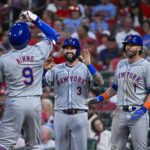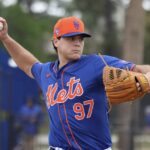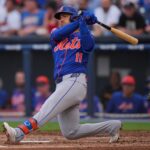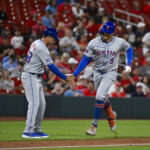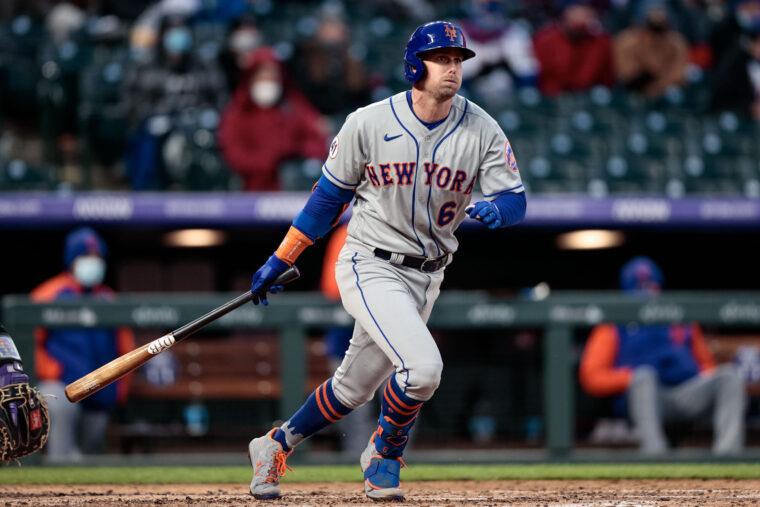
Credit: Isaiah J. Downing-USA TODAY Sports
Disclaimer: This article is not implying that Jeff McNeil will have the same career as Ichiro Suzuki. The purpose of this article is to highlight the similar characteristics that both McNeil and Ichiro share. A player’s approach is up to them and McNeil plays in a very different era than Ichiro, which will lead to different hitting philosophies. I was not trying to compare their career achievements, this was only meant to serve as an analysis of the qualities that make them very special and unique players. Also, all the information in this article was from before McNeil returned from the IL on 6/21/21.
Here is the batting average leaderboard for all qualified MLB players in the 21st century (min. 1000 PAs):
- Barry Bonds (.322)
- Vladimir Guerrero (.318)
- Todd Helton (.317)
- Manny Ramirez (.315)
- Larry Walker (.315)
- Magglio Ordonez (.312)
- JEFF MCNEIL (.312)
- Miguel Cabrera (.311)
- ICHIRO SUZUKI (.311)
Out of those first nine hitters, only two of them have a slugging percentage lower than .500, Jeff McNeil and Ichiro Suzuki.
In fact, many of their traditional stats are pretty similar to each other. Here is a tweet by the great Jeremy Frank comparing the two:
Through 815 career plate appearances:
Ichiro:
264-for-758
40 doubles, 9 triples, 8 home runs
346 total bases
38 walks
.348/.384/.456Jeff McNeil:
236-for-735
49 doubles, 7 triples, 26 home runs
377 total bases
49 walks
.321/.383/.513— Jeremy Frank (@MLBRandomStats) April 4, 2020
Through their first 815 career PAs, McNeil had a higher slugging percentage, more XBHs and more HRs, while Suzuki had more hits, a higher batting average, and a higher on-base percentage.
Beyond having similar stats, McNeil and Suzuki are both exceptional at a few key characteristics that play a large role in why their stats are similar.
The biggest trait they share is their amazing ability to get down the line exceptionally quick. Unfortunately, HP to 1B times have only been tracked by Statcast since 2015, so while we do not have prime Ichiro times, we can still try to get a sense of how fast he truly was.
In a Fangraphs article written by August Fagerstrom, he analyzed videos of Suzuki beating out infield hits to determine how long it takes him to get from HP to 1B. Based on his clocking times of Ichiro, the fastest time he found was 3.66 seconds, which would easily be the fastest of any player in the Statcast era. According to Statcast, the fastest average HP to 1B time in a season was Roman Quinn in 2018 at 3.88 seconds. His average sprint speed for that season was at 30.2 ft/sec.
While McNeil only has a career 27.4 ft/sec, which is considered to be almost exactly league average (27 ft/sec), he is still able to get down the line exceptionally quick, just like Ichiro. Here is a graph I made showing every player’s sprint speed compared to their HP to 1B time this season:
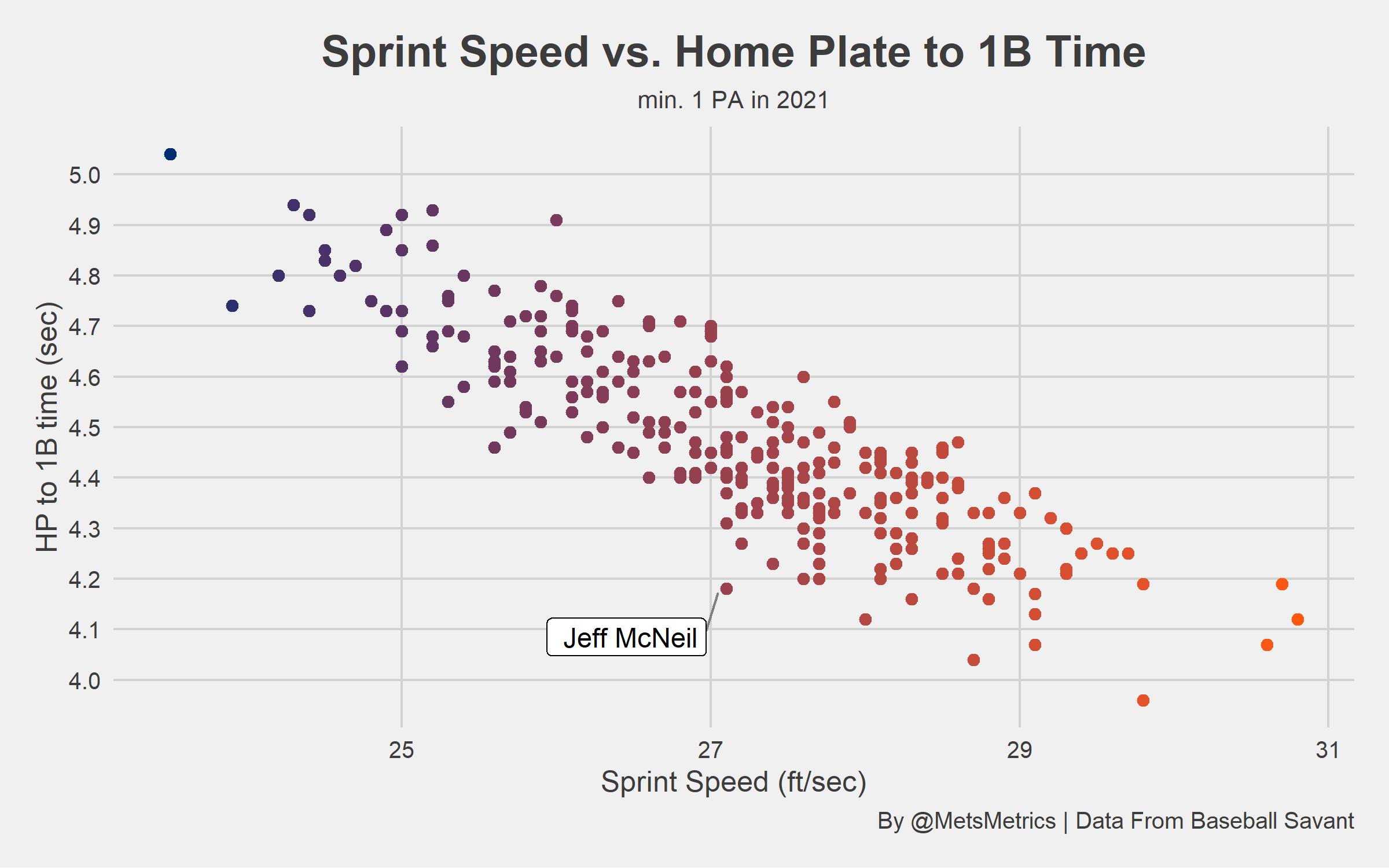
So far in 2021, McNeil has the fastest time down the line to first base out of any player that has a sprint speed slower than 28 ft/sec. McNeil actually has a faster HP to 1B time than Jorge Mateo, who has an elite sprint speed of nearly 31 ft/sec.
Now, I have to mention that left-handed hitters are able to get to first quicker than their right-handed hitting counterparts because they have less distance to travel running out of the box, but McNeil and Suzuki still have one of the fastest times even in comparison to other lefties.
Expanding that graph from just 2021 to all the years of Statcast tracking, from 2015-2021, here is a look at all players that have had at least 10 plate appearances during that time frame:

Out of 1054 players, Nori Aoki is the only player since 2015 who has a slower sprint speed and a quicker HP to 1B time than McNeil and Suzuki. This is clearly a skill that they have developed.
In order to visualize their unique ability to get down the line, I wanted to create an overlay of their batting stances and swings to see if there were any similarities:

In trying to create the most accurate comparison possible, I wanted to find a similar clip of them in order to show the similarities/differences between their swings. In both clips, it is a left-handed pitcher and the ball was in the bottom edge of the strike zone.
I also tried my best to sync up the videos so that they make contact at the same exact time. Along with that, the result of both plays is the same, an infield single. The video from McNeil is unfortunately from the same play where he hurt his hamstring in early May 2021, while the video from Ichiro is from April 2002, the start of his second MLB season.
To my surprise, they are almost mirror images of each other up until they make contact with the ball. While they both basically start running towards first base after making contact with the ball, it looks like Suzuki is able to get a small head start because he peels off the ball a bit quicker.
Here are a few still images from the pre-pitch setup, load, and launch showing how their stances are virtually identical to each other:
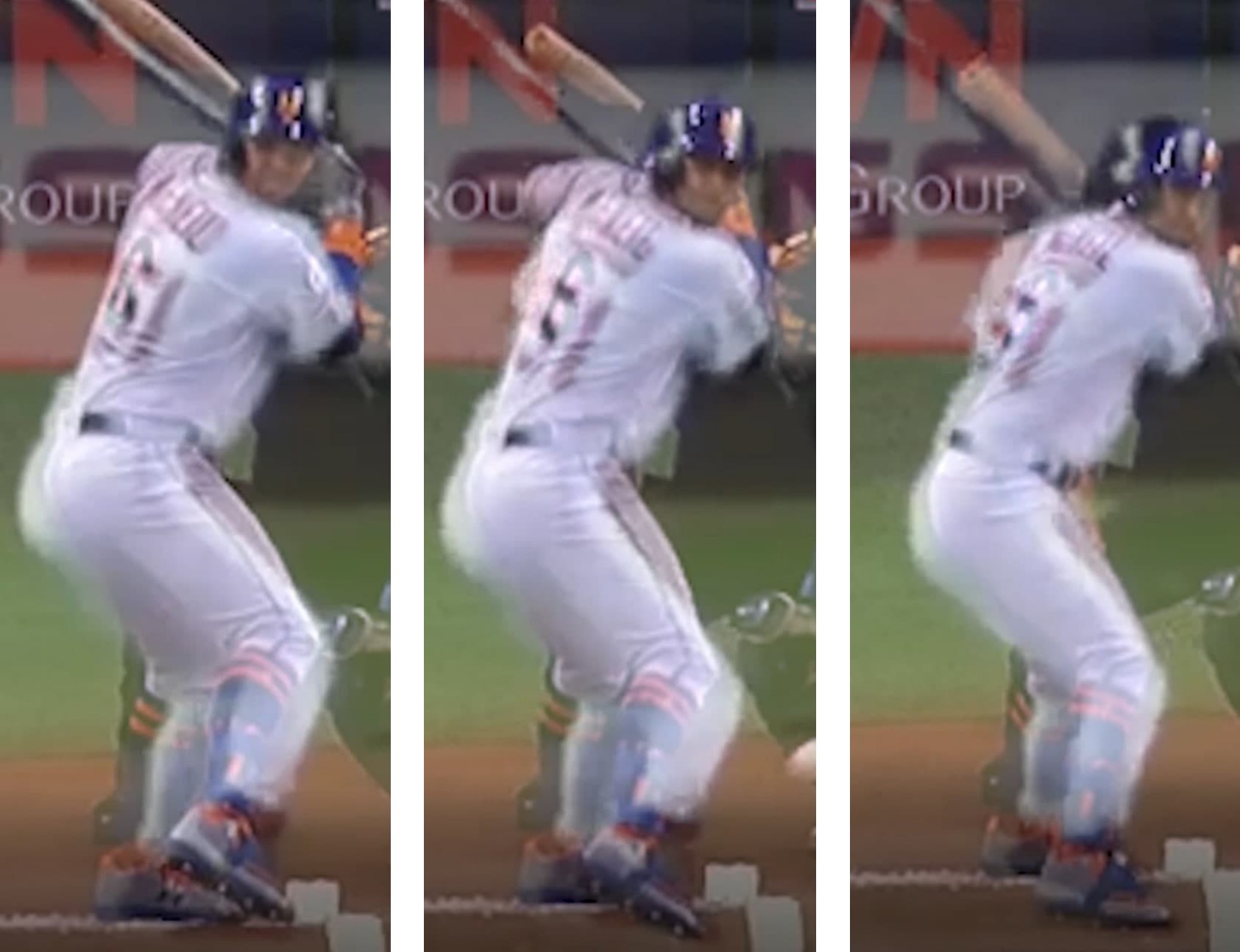
In these three images, it is hard to tell the two apart because of how similar their stances are. It’s only after contact is made with the ball that you begin to notice some of the differences between both of them.
The biggest thing that stuck out to me was how quickly Suzuki can get out of the box after he swings, as he gets nearly a full step of extra separation compared to McNeil. This definitely plays a huge role in how Suzuki was able to get down the line so quickly. Along with that, you’ll see the first real noticeable difference between their two swings is the point where the bat makes contact with the ball, as Ichiro’s right shoulder starts leaning towards first base more than McNeil’s. Here is a still image of that:

Even as Ichiro got older, his swing remained the same and his ability to get down the line was still elite. While he was not as fast, he clearly mastered the skill of being able to get down the line extremely quickly.
One byproduct of this skill is their ability to convert grounders into infield hits. While Suzuki hits into more grounders/bunts than McNeil (largely due to the era they played in), Jeff still routinely finishes in the top half of the league in terms of infield hit percentage, which is measured by the number of infield hits divided by ground balls. As you could probably guess, Suzuki was always one of the league leaders in infield hit %, but McNeil is surprisingly good at getting infield hits considering his league average speed.
To give a visual representation of how their infield hit % compared in their own eras, I created a graph of both McNeil and Suzuki’s infield hit rates over the course of four seasons. Since the first year of batted ball data that is available on Fangraphs started in 2002, I used the time span from 2002-2005 for Ichiro, while I used 2018-2021 for McNeil, which spans his entire career:
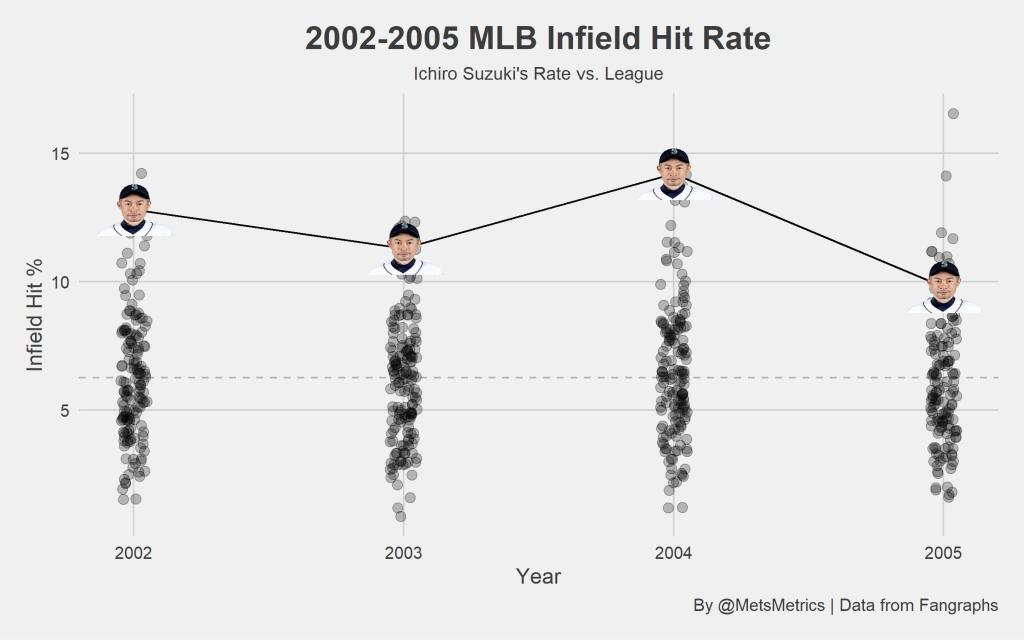
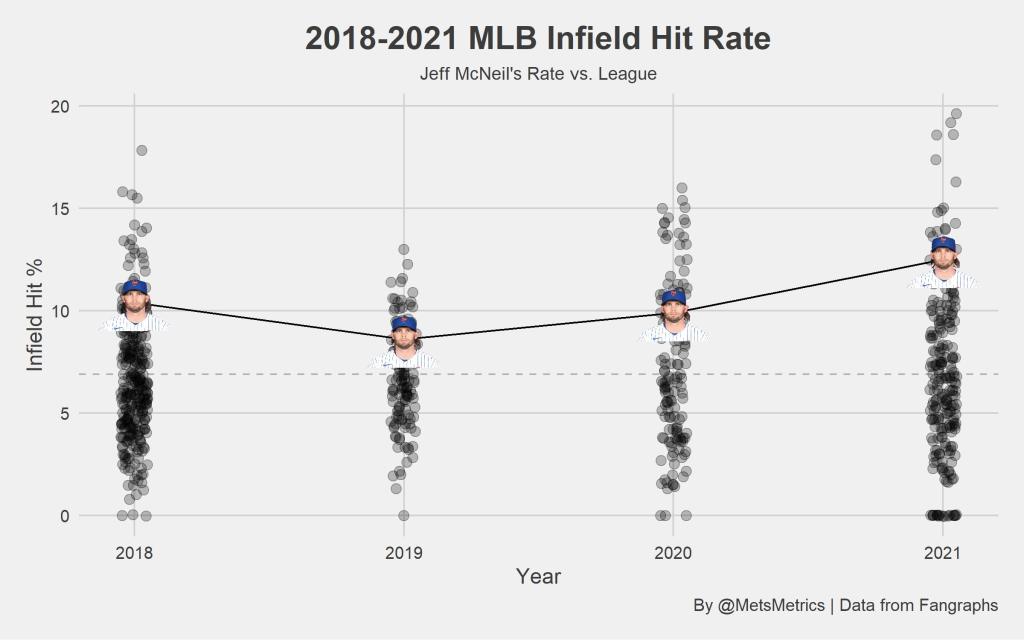
The main thing you’ll probably notice is how much higher Ichiro ranks amongst his peers compared to McNeil. Since this was early in Ichiro’s career, this was when he easily had a 30+ ft/sec sprint speed. Considering that Suzuki had elite sprint speed and was also amazing at getting down the line, it makes sense how he was able to get so many infield hits in his career.
Even though McNeil’s rankings look relatively low when compared with Ichiro, he has always been in the top half of the league in infield hit rate, even with his average sprint speed. This is not an aspect of McNeil’s game that many people think of, yet it has helped him convert a lot of potential ground ball outs to infield hits.
Getting infield hits is not the only way that McNeil and Ichiro are similar, however. In fact, by looking at their strikeout and walk rates, it is clear these two on-base machines have even more in common with one another.
As I’ve mentioned before, the eras they played in were quite different, and nowadays, K rate is skyrocketing compared to what it was in the early 2000s. Due to this influx of strikeouts, I wanted to look at each of their K%-BB% within their own eras, to see how they compare to their peers. Unlike K/BB or BB/K, I like using K%-BB% because it places an equal emphasis on both strikeout and walk rates.
I must preface my next chart by mentioning that I removed Barry Bonds from the early 2000s data simply because of how much he skewed the data. I’m sure everyone knows how much of an outlier Bonds was in the early 2000s, so I thought it was fairer to Ichiro if I eliminated Bonds and his astronomical walk rates. Anyways, here are both Jeff McNeil’s and Ichiro Suzuki’s K%-BB% from their first four MLB seasons:
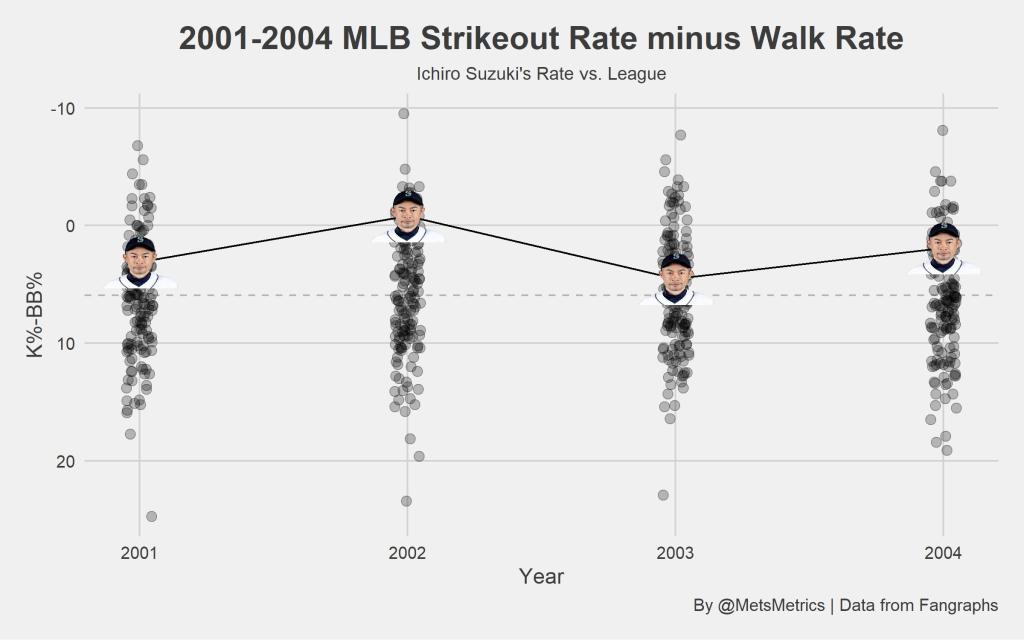
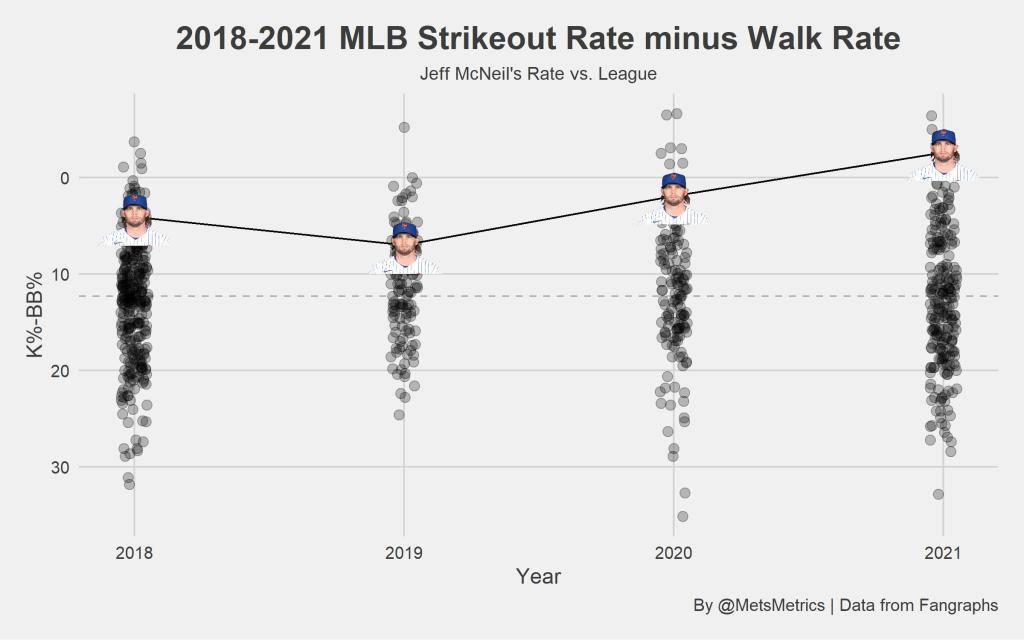
Since a player ideally wants to walk more and strikeout less, I flipped the y-axis because a lower K%-BB% is better. A negative K%-BB% means that the player has a higher walk rate than strikeout rate.
You’ll notice that on Ichiro’s chart from 2001-2004, there are more dots (players) that have a negative K%-BB% compared to 2018-2021. As I briefly touched on earlier, the reason for that is the increase in strikeouts, which have steadily been increasing across the MLB since 2009.
Even though McNeil plays in a very strikeout-heavy era, he is an old-school hitter, as his K% is routinely amongst one of the lowest in the leagues. If you compare both McNeil and Suzuki’s K%-BB% in their first four seasons, disregarding era, you’ll see that they are very similar to each other, as neither of them had a K%-BB% over 7%.
Looking at their K%-BB% within their eras, McNeil was in the upper 10th percentile in three out of his four career seasons while Suzuki only did that once in his first four seasons. While this is only looking at a four-year sample size, since that is all of McNeil’s career, Suzuki maintained a similar K%-BB% for almost 13 straight seasons.
That leads me to one of the main differences between the two, which is durability.
Ichiro Suzuki played at least 140 games in 16 consecutive MLB seasons and had at least 600 ABs in 12 consecutive MLB seasons. McNeil hasn’t reached either of those milestones in any of his seasons so far. Now, some of it isn’t McNeil’s fault. In 2018, he got called up in late July and played virtually every day to end the season, while in 2020, he played in 52 games out of the 60 possible, which would translate to about 140 games if it was a full 162 games.
Even though Suzuki made his MLB debut at 27 years old, he took his final MLB at-bat at the age of 45, which is truly remarkable if you also consider the nine years he spent in Japan before going to Seattle.
If McNeil can remain relatively healthy throughout his career and can play for a long period of time, I am confident that McNeil’s overall career stats and accolades could start to look pretty similar to Ichiro Suzuki.





